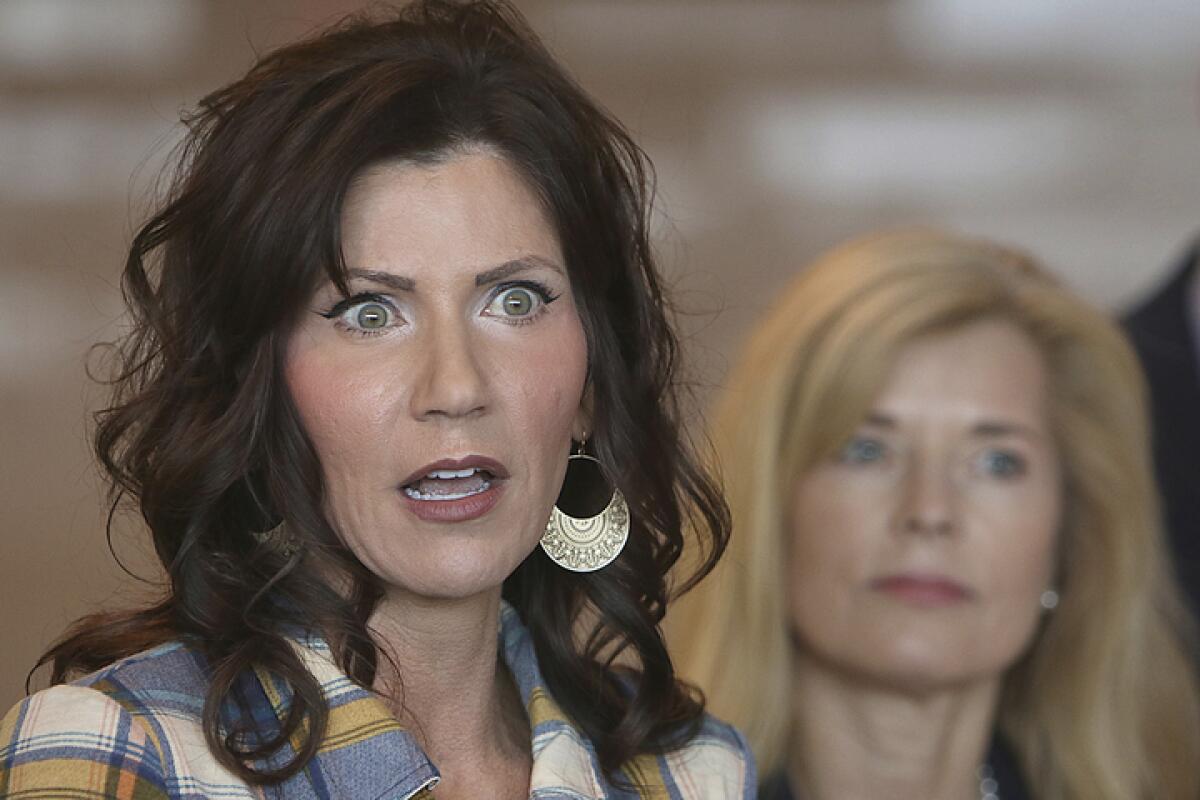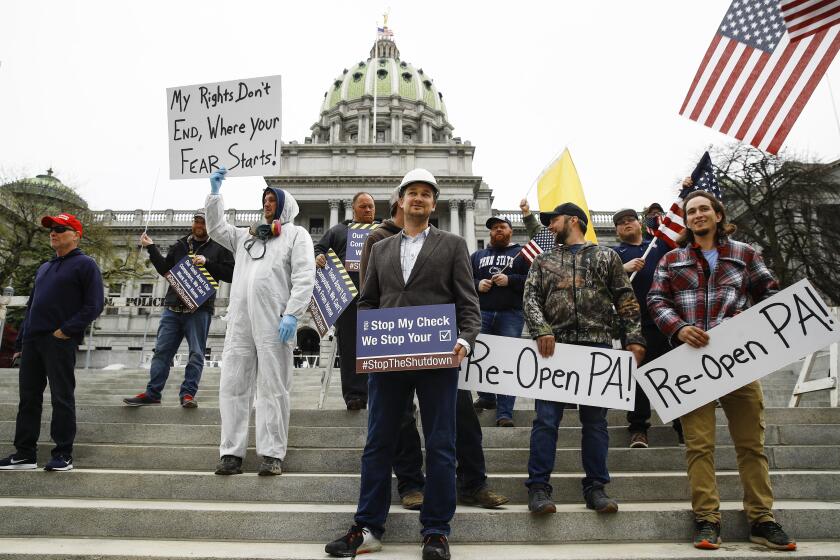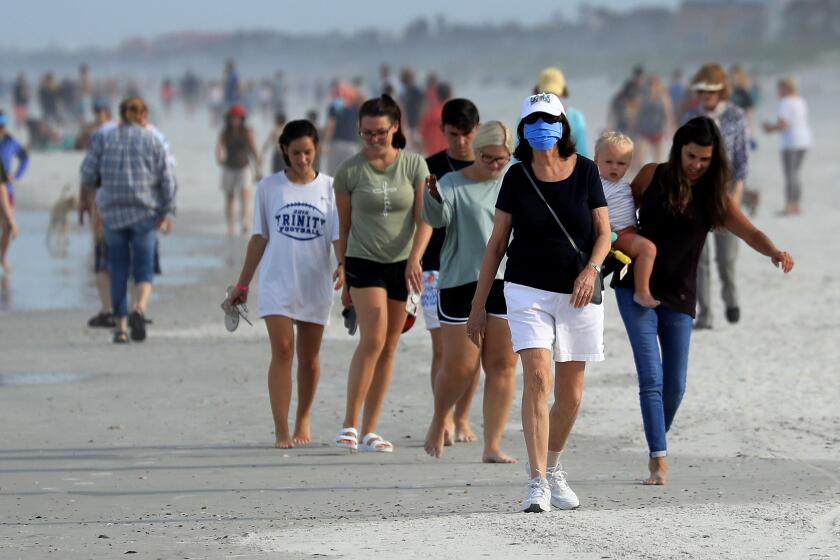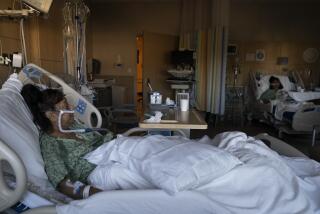These eight states haven’t issued stay-at-home orders to fight the coronavirus outbreak

- Share via
California became the first state to issue a stay-at-home directive, effective March 19, and 41 states and the District of Columbia have followed. Eight states have not.
The leaders of Arkansas, Iowa, Nebraska, North Dakota, South Dakota, Oklahoma, Utah and Wyoming have taken steps to limit the size of gatherings, close schools and some nonessential businesses, and prohibit on-site dining at restaurants. But they have stopped short of directing all residents to stay home except for essential business.
The Republican governors in those states have defended their decisions, arguing that their hospitals aren’t overrun and their rural states haven’t been hit as hard as others with denser urban centers, such as New York, Washington or Louisiana. The governors have said they don’t want to hurt small businesses or infringe on individual freedoms.
At the same time, several of the states are dealing with outbreaks at meat processing plants, senior homes and long-term care facilities, and prisons that have raised concerns about the absence of stricter regulations. A lack of widespread testing, experts say, makes it difficult to gauge the full extent of the outbreak. Two studies in California suggest official counts have missed thousands of cases as a result of a slow start to testing and shortages that prioritized people showing symptoms. Several states have sought to increase testing or are focusing testing in areas with growing outbreaks, but for now official tallies offer only an estimate.
Here’s what those governors have done so far, and why they don’t plan to issue a stay-at-home order.
Arkansas
Gov. Asa Hutchinson has closed schools and fitness centers, banned on-site dining at restaurants and prohibited indoor social gatherings of more than 10 people.
But he has stopped short of a stay-at-home order and has blocked local leaders, including the mayor of Little Rock, from issuing stricter orders. Hutchinson said his administration has worked with mayors on targeted responses, but he wants to take a “long-term approach” to combat the outbreak.
“You’re not going to win simply by a lockdown because there’s no such thing as a true lockdown where everybody stays at home and does not go out,” he said April 12 on CNN’s “State of the Union.” “The most important message is you wear your mask, you do your social distancing. And the people of Arkansas have embraced that.”
Life is slowly returning to normal in some parts of the U.S. amid the coronavirus pandemic. But health experts warn a rapid reopening could quickly go wrong.
The state of 3 million people has more than 2,270 confirmed coronavirus cases and 43 COVID-19 deaths, according to data compiled by Johns Hopkins University. There has been a massive outbreak at the Cummins Unit state prison, where 670 inmates tested positive as of Tuesday, according to the Associated Press.
The governor said Sunday that he’d asked the state parole board to identify and review nonviolent offenders not convicted of sex crimes who are near the end of their sentences to be considered for early release.
Iowa
Gov. Kim Reynolds has stopped short of issuing a stay-at-home order, but she has closed schools and some businesses and banned public gatherings of more than 10 people.
In the northeast region of the state, which includes Cedar Rapids and Dubuque, she’s issued stricter rules that limit “social, community, recreational, leisure and sporting gatherings” to only people who live in the same household. Weddings, funerals and religious gatherings of no more than 10 people are allowed if participants practice social distancing measures.
The move followed coronavirus outbreaks at long-term care facilities and meat processing plants in the region. The state has had more than 3,740 confirmed cases and 90 COVID-19 deaths. About 3.2 million people live in Iowa.
Reynolds has argued that her approach is equivalent to a stay-at-home order. “We’re gonna continue to look at metrics and we’ll make decisions based on that, but the end result is the same,” she said at a March 25 news conference.
At an April 6 White House briefing, Anthony Fauci, the director of the National Institute of Allergy and Infectious Diseases, said the actions taken by Iowa and neighboring Nebraska are “functionally equivalent” to a stay-at-home order.
“I want to make sure people understand that just because they don’t have a very strict stay-at-home order, they have in place a lot of things that are totally compatible with what everyone else is doing,” he said.
Nebraska
On April 3, Gov. Pete Ricketts announced that the state was under a “directed health measure,” closing schools, limiting bars and restaurants to takeout or delivery, banning large public gatherings and elective surgeries. The order doesn’t close nonessential businesses, including malls, though some counties have issued stricter measures. Ricketts closed salons, indoor theaters and tattoo parlors on April 10.
Hall County, Nebraska’s fourth-largest, has become the epicenter of the state’s cases. There were 558 confirmed cases in the county as of Tuesday afternoon, 237 of which were tied to the JBS meatpacking plant in Grand Island, according to the Omaha World-Herald. In the state of 1.9 million people, there have been more than 1,720 confirmed cases and 38 deaths, according to Johns Hopkins.
North Dakota
Gov. Doug Burgum has also argued that the measures he’s taken add up to a stay-at-home order. In a series of executive orders signed between mid-March and early April, he closed schools, gyms, movie theaters and person grooming businesses like salons and tattoo parlors. Visitors are banned from long-term care facilities. People who test positive for the coronavirus must quarantine at home for 14 days along with family members.
“This isn’t as much about what government says, it’s more about what individuals do,” Burgum said this month.
About 762,000 people live in the state, which has seen more than 670 confirmed cases and 14 deaths, according to Johns Hopkins.
South Dakota
“South Dakota is not New York City,” Gov. Kristi Noem said April 1.
Though schools have been closed since March 16, Noem has not closed businesses or banned public gatherings. She has ordered residents older than 65 or with underlying health conditions in two counties to stay home, limited government gatherings and directed businesses to follow Centers for Disease Control and Prevention guidelines on social distancing, all while emphasizing the importance of protecting civil liberties.
Some states are starting to allow businesses to reopen amid the COVID-19 outbreak. But mayors and public health experts say it could be too early.
“I believe in our freedoms and liberties. What I’ve seen across the country is so many people give up their liberties for just a little bit of security and they don’t have to do that,” Noem said during a Fox News interview last week. “If a leader will take too much power in a time of crisis, that is how we lose our country.”
The state of 884,000 people has had more than 1,850 confirmed cases and nine deaths. South Dakota now has one of the largest outbreak hot spots in the country, at a Smithfield Foods pork processing plant in Sioux Falls.
Smithfield announced April 12 that the factory, one of the biggest in the country, would close indefinitely. More than 700 employees at the facility have tested positive for the coronavirus. Noem argued that a stay-at-home order wouldn’t have prevented the outbreak because the facility is an essential business.
“Let’s be perfectly clear: a shelter-in-place order would NOT have prevented Smithfield from happening,” she tweeted April 15. “They are a critical infrastructure business.”
On March 26, Sioux Falls, the state’s largest city, passed a “no lingering” law limiting the number of patrons who can visit a business at one time to 10 or fewer in a bid to encourage social distancing. Republican Mayor Paul TenHaken issued a voluntary proclamation encouraging residents to stay home. TenHaken asked Noem to issue a stay-at-home order, but she declined.
Oklahoma
Nearly 4 million people live in Oklahoma, which has more than 2,800 confirmed cases and 170 COVID-19 deaths. The state has closed schools and nonessential businesses, but Gov. Kevin Stitt has issued stay-at-home orders only for at-risk populations such as the elderly and those with preexisting health conditions. Mayors in the state’s biggest cities, including Oklahoma City and Tulsa, have issued blanket stay-at-home orders.
“Unlike the safer-at-home order issued earlier this week by the governor, for which I am very grateful, this safer-at-home order applies to everyone in Tulsa, not just those over 65,” Tulsa Mayor G.T. Bynum said at a March 29 news conference.
Utah
Gov. Gary Herbert has issued a series of guidelines encouraging people to stay home and practice social distancing and good hygiene. Schools and nonessential businesses such as fitness centers are closed. On Friday, Herbert announced plans to slowly begin to reopen the state as soon as May.
“We don’t want to go too fast, but we also don’t want to go too slow either,” Herbert said. “It not just only about healthcare; it’s also concern about the livelihood of those we represent too.”
About 3.2 million people live in Utah, which has more than 3,440 confirmed coronavirus cases and 32 COVID-19 deaths. Some counties have issued strict stay-at-home orders.
Wyoming
Gov. Mark Gordon closed schools and some businesses and prohibited gatherings of 10 or more people. During an April 3 news conference, Gordon said he and his administration have encouraged people to stay home, wash their hands, go to the store only when necessary and not gather in large groups.
“That is essentially what a stay-at-home order is,” he said. “And if you’re waiting for me to issue a ‘shelter in place’ order when ... I’m telling you to stay home, what are you waiting for? Are you waiting for ‘Mother, may I?’ or are you taking care of yourself and practicing the common sense that we expect? One of our Wyoming values is talk less and say more. Our orders talk less and say more.”
About 579,000 people live in Wyoming, which has had more than 440 confirmed cases and six deaths. Jackson, a town of about 10,000 people, issued a stay-at-home order March 28.
More to Read
Sign up for Essential California
The most important California stories and recommendations in your inbox every morning.
You may occasionally receive promotional content from the Los Angeles Times.












